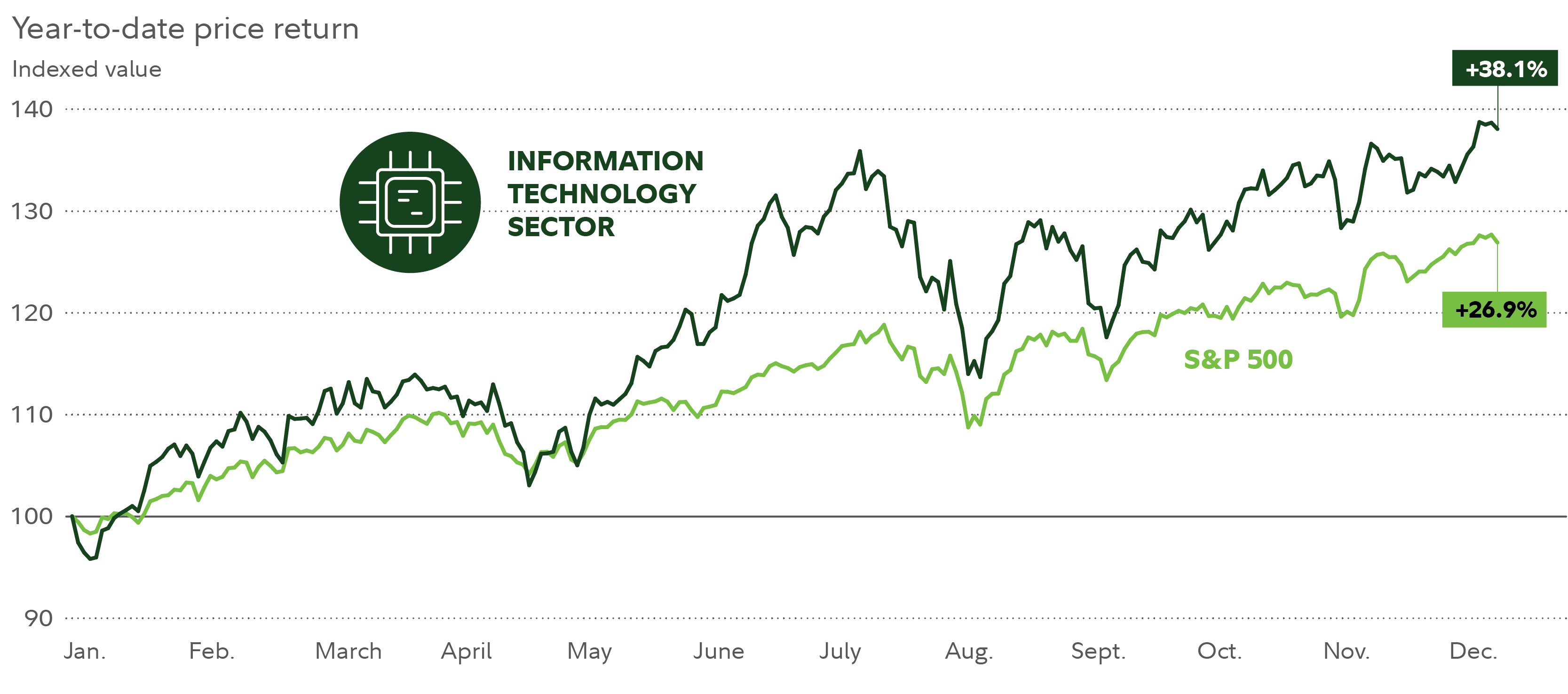Tech stocks had another spectacular year in 2024—the sector’s second-straight year of market-leading returns.
For 2025 and beyond, I believe the sector is still well positioned. Tech has continued to be the source of the most exciting advances in how we work and live. The impacts of generative AI may be unfolding for many years to come, as may the increased digitization and automation of our lives—all of which could continue to drive results for the semiconductor makers, software makers, and other companies that populate this sector.
2024: Fueled by strong results
The tech sector benefited in 2024 from standout results in the semiconductor industry, reflecting major corporate investments in AI infrastructure. While the sector took a breather in the second half of the year amid high valuations and questions about the timeline for AI development, as of mid-December tech was still one of the top-performing sectors for the year.

2025: Compelling near-term dynamics for semiconductors
Although some semiconductor stocks have been at the forefront of the tech sector’s big gains in recent years, the chip industry has actually been bifurcated over this period. The stocks of companies linked to AI, like NVIDIA (
I believe there could be attractive potential in the year ahead for these “non-AI-winner” chip makers. The broader semiconductor industry is more than 2 years into an inventory correction. After the pandemic initially caused dramatic shortages for semiconductors, the industry responded by ramping up production—leading to one of the worst oversupply conditions in decades.
However, I believe these oversupply dynamics are likely to prove temporary and could be poised to resolve soon. One catalyst for this could be a coming AI-driven product-upgrade cycle, as AI adoption begins to reach across all technology devices and end markets. Any lift to the general economic environment, perhaps aided by lower interest rates, could help as well.
Fund top holdings1
Top-10 holdings of the Fidelity® Select Technology Portfolio (
- 22.3% – NVIDIA Corp. (
- 17.5% – Apple Inc. (
- 11.4% – Microsoft Corp. (
- 4.5% – Marvell Technology Inc. (
- 3.9% – ON Semiconductor Corp. (
- 3.8% – NXP Semiconductors NV (
- 3.0% – ServiceNow Inc. (
- 2.6% – Cisco Systems Inc. (
- 2.6% – Salesforce Inc. (
- 2.3% – Okta Inc. (
(See the most recent fund information.)
Fidelity® Select Technology Portfolio (
Both companies have been well positioned to capitalize on rising electronic content in autos that make cars more and more like “smartphones on wheels.” This increasing electronic content could enable chip sales to auto companies to strongly outpace overall auto sales growth in the coming years.
2025 and beyond: Massive AI spending driving potential opportunities
While it’s important not to overlook such non-AI beneficiaries, AI is still squarely at the center of the industry’s near- and long-term outlook.
AI spending continued at a rapid pace in 2024, dominating capital budgets for many companies. Tied up in the AI spend has been the simultaneous move to “accelerated computing,” in which the most data-intensive tasks run on specialized hardware. The biggest spenders were the large cloud-services providers, including the tech sector’s Microsoft Corp. (
Much of this spending spree accrued to infrastructure firms—the providers of the graphics processing units, high-speed memory, and other “picks and shovels” that enable the high-speed computing required to develop and operate generative AI applications. For example, graphics chipmaker Nvidia has, in my opinion, offered the purest way to gain exposure to generative AI. The company has been investing in AI for about a decade, and its end-to-end solutions of chips, software, and systems have positioned it extremely well as the provider of choice for “hyperscalers,” or large cloud-services providers, and enterprises looking to embrace generative AI.
There’s only been modest benefit, so far, to companies that employ AI—such as with Microsoft’s Copilot AI, which supports its software suite, and Intuit Inc.’s (
ServiceNow (
Exciting prospects for the future
As the advent of generative AI has shown, the tech sector has been a seemingly limitless fount of innovation for our everyday lives, from PCs to smartphones, to EVs, and more. There is already evidence of AI-driven gains in productivity, customer service, coding, graphic design, and translation services, and I believe AI could eventually be disruptive to the way most work is performed. Progress may not be linear, though, and investors must be mindful of stock valuations and the timing and potential impact of further technological advances in the field, as well as the broader macroeconomic environment.
This is an exciting time for the tech sector, and I look forward to continuing to monitor developments and innovations through 2025 and beyond.

Adam Benjamin is a research analyst and portfolio manager in the Equity division at Fidelity Investments.
Mr. Benjamin manages the Fidelity Advisor Technology Fund, Fidelity VIP Technology Portfolio, Fidelity Select Semiconductors Portfolio, Fidelity Select Technology Fund, Fidelity Advisor Semiconductors Fund and the information technology sleeves of the Fidelity Institutional Asset Management (FIAM) Large Cap Core and Global Core sector strategies. He also covers the large cap semiconductors industry.
Prior to assuming his current roles, Mr. Benjamin was a research analyst responsible for the coverage of the semiconductor, semiconductor capital equipment, and solar end markets. Most recently he served as global technology sector leader within FIAM.
Before joining Fidelity in 2011, Mr. Benjamin served as managing director and head of semiconductor equity research at Jefferies & Company, Inc. Previously, he held various roles at SG Cowen, including senior research associate focused on the semiconductor space and vice president in the Technology M&A group. Mr. Benjamin was also an associate in the Corporate Law department of Sullivan & Worcester. He has been following the technology sector for over 18 years.
Mr. Benjamin earned his bachelor of arts degree from Cornell University and his juris doctor degree, cum laude, from Suffolk University Law School.



